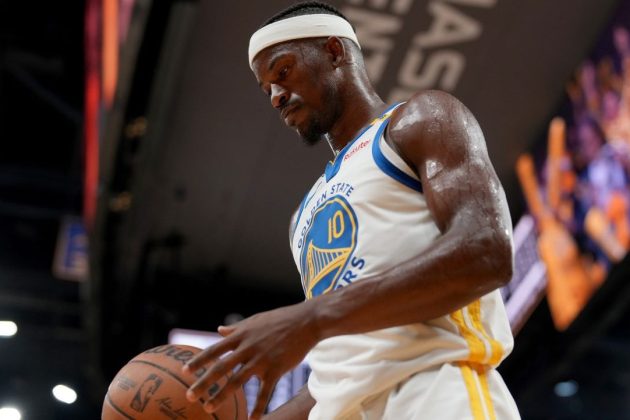Jimmy Butler scored 38 points in the Golden State Warriors’ NBA Play-In Tournament win over the Memphis Grizzlies on Tuesday night. Before then, Butler hadn’t eclipsed 30 points in any regular season game since he was traded to the Bay Area on Feb. 6.
Fans rejoiced at the arrival of “Playoff Jimmy”—a nickname minted during past playoffs with the Miami Heat.
“You could just see a whole different intensity level and focus,” teammate Draymond Green said after the Grizzlies game. “There [are] a lot of nicknames out there—they’re not real. That one’s real.”
Butler led the Heat to the NBA Finals twice as a No. 5 seed or lower, and the Warriors acquired him hoping he could bring similar magic to Chase Center. Since his first All-Star appearance in 2015, he has upped his scoring average from 21.0 points per game in the regular season to 23.3 points per game in the playoffs—without sacrificing efficiency.
Join Sportico for Invest West at the Intuit Dome on May 8
Other players decline in the postseason. For example, Joel Embiid, the NBA’s 2022-23 MVP, has averaged three points fewer in the playoffs than the regular season, with a dip in true shooting percentage to boot.
Because the playoff schedule is spread out with days off between every game, players get more rest and coaching staffs more preparation time. Teams can build game plans to expose opponents’ weaknesses and hide their own, a luxury not afforded by the frantic regular season calendar.
If a player’s go-to moves on offense are scouted and taken away, they may not have sufficient counters. If a player can’t defend a certain action, they might get played off the floor and subbed out for a teammate who can.
In the postseason, the style of the game is distinct, too, in measurable ways. Here are a few examples.
1. Pace Slows
In all but two seasons since 1980, there were fewer possessions per game in the playoffs than in the regular season. In 2024, for example, teams had 98.5 offensive possessions per game in the regular season and only 92.6 in the postseason, one of the largest disparities in league history. Increased focus and effort limit opponents’ fastbreak opportunities, and tighter half-court defense leads to more drawn-out possessions.
As the postseason goes on, the intensity ramps up further, slowing down the game even more. Seventeen of the past 20 NBA Finals have been played at a slower pace than the rest of the playoffs.
2. Teams Shoot More 3s
Stingier playoff defense makes it more difficult for teams to generate open shots close to the basket. Indeed, paint touches have consistently declined in the postseason throughout the player tracking era since 2014. As a result, teams settle for more long jumpers.
In all but two years since the 1980 inception of the 3-point line, a higher percentage of shots were taken from 3-point range in the playoffs than in the regular season. The past few seasons, however, this trend has become much less pronounced.
3. Teams Make Fewer 3s
Teams choose to live and die by the 3-pointer in the playoffs, but shooting percentages go down when the pressure is higher. Of the 224 playoff squads since 2010, excluding those in the 2020 playoff bubble, nearly three-quarters (72%) shot worse from behind the 3-point line during the postseason than the regular season.
4. More Isolation Offense
As robust defenses shut down the plays teams have used throughout the season, superstars must rely on individual brilliance. Teams have relied more on isolation offense in every postseason since 2016. Relatedly, there are fewer passes and fewer assists during the playoffs.
5. More Fouls
The aggressive postseason defense that limits transition opportunities and shots around the basket while forcing teams out of their offensive sets does come at a cost: more fouls.
The notion that the refs “let ‘em play” in the playoffs hasn’t historically been true. The percentage of 2-point shots that yield free throws was higher in the postseason than the regular season in 19 of the first 22 years this century, per PBP Stats.
Notably, the past two years were exceptions. In the 2022-23 regular season, the foul rate on shot attempts inside the arc skyrocketed, as refs gave offensive players more leeway to initiate contact and “draw” fouls. In the 2023 playoffs, though, officials swallowed their whistles more and brought that rate back to normal.
Halfway through the 2023-24 regular season, after foul rates reverted to the previous year’s highs, the NBA responded to criticism by allowing more defensive physicality, and that carried over into the 2024 playoffs as well.
In the 2024-25 regular season, the foul rate has been much closer to the first half of 2023-24 than the adjusted post-All-Star break norm. We will see how the referees decide to officiate contact in this year’s playoffs, but either way, it will be a whole different ball game from the past six months.
Sign up for Sportico’s Newsletter. For the latest news, follow us on Facebook, Twitter, and Instagram.
Jimmy Butler scored 38 points in the Golden State Warriors’ NBA Play-In Tournament win over the Memphis Grizzlies on Tuesday night. Before then, Butler hadn’t eclipsed 30 points in any regular season game since he was traded to the Bay Area on Feb. 6.
Fans rejoiced at the arrival of “Playoff Jimmy”—a nickname minted during past playoffs with the Miami Heat.
“You could just see a whole different intensity level and focus,” teammate Draymond Green said after the Grizzlies game. “There [are] a lot of nicknames out there—they’re not real. That one’s real.”
Butler led the Heat to the NBA Finals twice as a No. 5 seed or lower, and the Warriors acquired him hoping he could bring similar magic to Chase Center. Since his first All-Star appearance in 2015, he has upped his scoring average from 21.0 points per game in the regular season to 23.3 points per game in the playoffs—without sacrificing efficiency.
Join Sportico for Invest West at the Intuit Dome on May 8
Other players decline in the postseason. For example, Joel Embiid, the NBA’s 2022-23 MVP, has averaged three points fewer in the playoffs than the regular season, with a dip in true shooting percentage to boot.
Because the playoff schedule is spread out with days off between every game, players get more rest and coaching staffs more preparation time. Teams can build game plans to expose opponents’ weaknesses and hide their own, a luxury not afforded by the frantic regular season calendar.
If a player’s go-to moves on offense are scouted and taken away, they may not have sufficient counters. If a player can’t defend a certain action, they might get played off the floor and subbed out for a teammate who can.
In the postseason, the style of the game is distinct, too, in measurable ways. Here are a few examples.
In all but two seasons since 1980, there were fewer possessions per game in the playoffs than in the regular season. In 2024, for example, teams had 98.5 offensive possessions per game in the regular season and only 92.6 in the postseason, one of the largest disparities in league history. Increased focus and effort limit opponents’ fastbreak opportunities, and tighter half-court defense leads to more drawn-out possessions.
As the postseason goes on, the intensity ramps up further, slowing down the game even more. Seventeen of the past 20 NBA Finals have been played at a slower pace than the rest of the playoffs.
Stingier playoff defense makes it more difficult for teams to generate open shots close to the basket. Indeed, paint touches have consistently declined in the postseason throughout the player tracking era since 2014. As a result, teams settle for more long jumpers.
In all but two years since the 1980 inception of the 3-point line, a higher percentage of shots were taken from 3-point range in the playoffs than in the regular season. The past few seasons, however, this trend has become much less pronounced.
Teams choose to live and die by the 3-pointer in the playoffs, but shooting percentages go down when the pressure is higher. Of the 224 playoff squads since 2010, excluding those in the 2020 playoff bubble, nearly three-quarters (72%) shot worse from behind the 3-point line during the postseason than the regular season.
As robust defenses shut down the plays teams have used throughout the season, superstars must rely on individual brilliance. Teams have relied more on isolation offense in every postseason since 2016. Relatedly, there are fewer passes and fewer assists during the playoffs.
The aggressive postseason defense that limits transition opportunities and shots around the basket while forcing teams out of their offensive sets does come at a cost: more fouls.
The notion that the refs “let ‘em play” in the playoffs hasn’t historically been true. The percentage of 2-point shots that yield free throws was higher in the postseason than the regular season in 19 of the first 22 years this century, per PBP Stats.
Notably, the past two years were exceptions. In the 2022-23 regular season, the foul rate on shot attempts inside the arc skyrocketed, as refs gave offensive players more leeway to initiate contact and “draw” fouls. In the 2023 playoffs, though, officials swallowed their whistles more and brought that rate back to normal.
Halfway through the 2023-24 regular season, after foul rates reverted to the previous year’s highs, the NBA responded to criticism by allowing more defensive physicality, and that carried over into the 2024 playoffs as well.
In the 2024-25 regular season, the foul rate has been much closer to the first half of 2023-24 than the adjusted post-All-Star break norm. We will see how the referees decide to officiate contact in this year’s playoffs, but either way, it will be a whole different ball game from the past six months.














